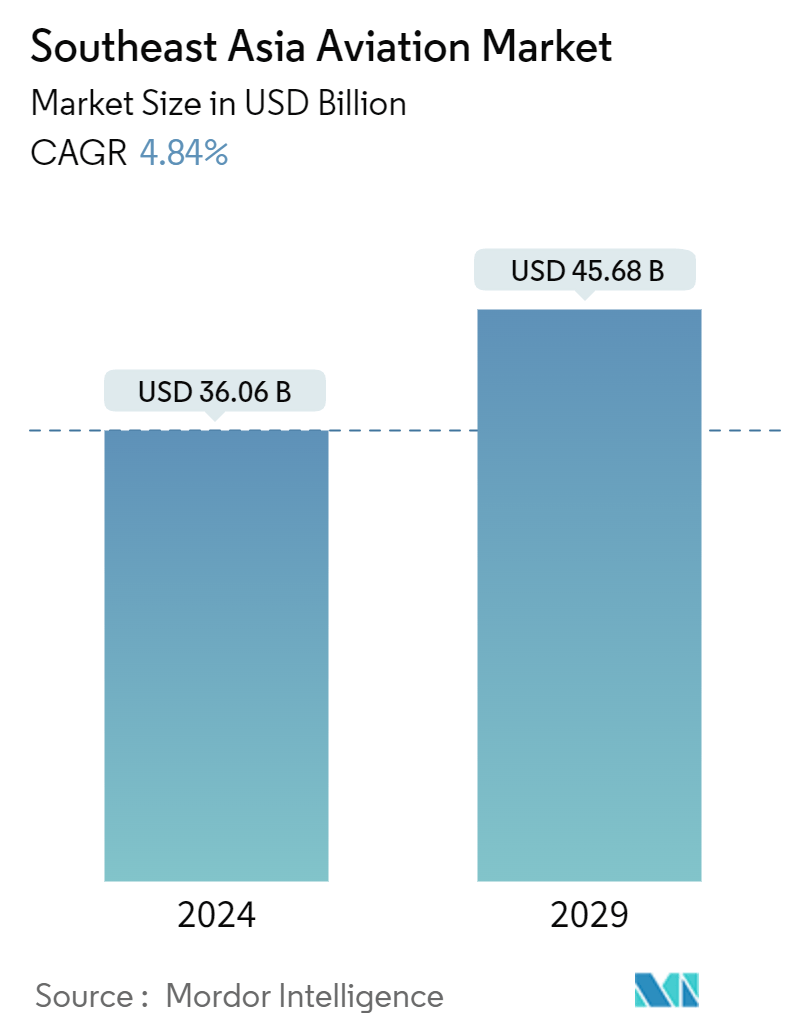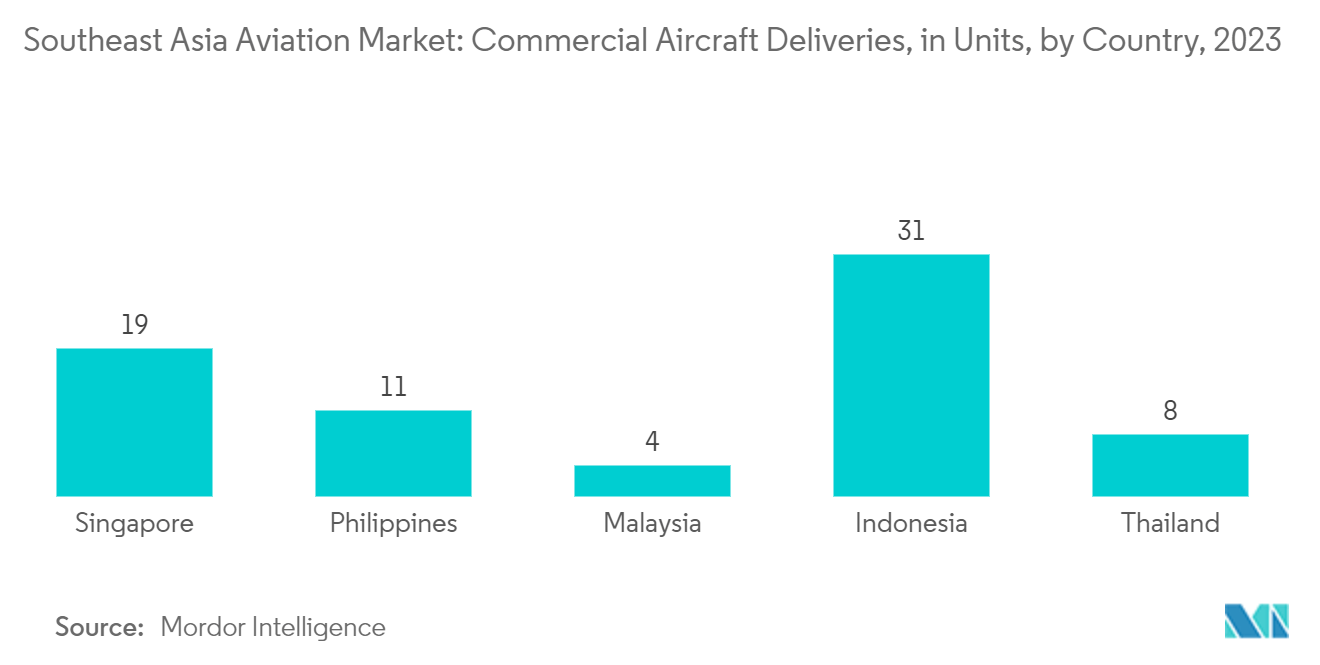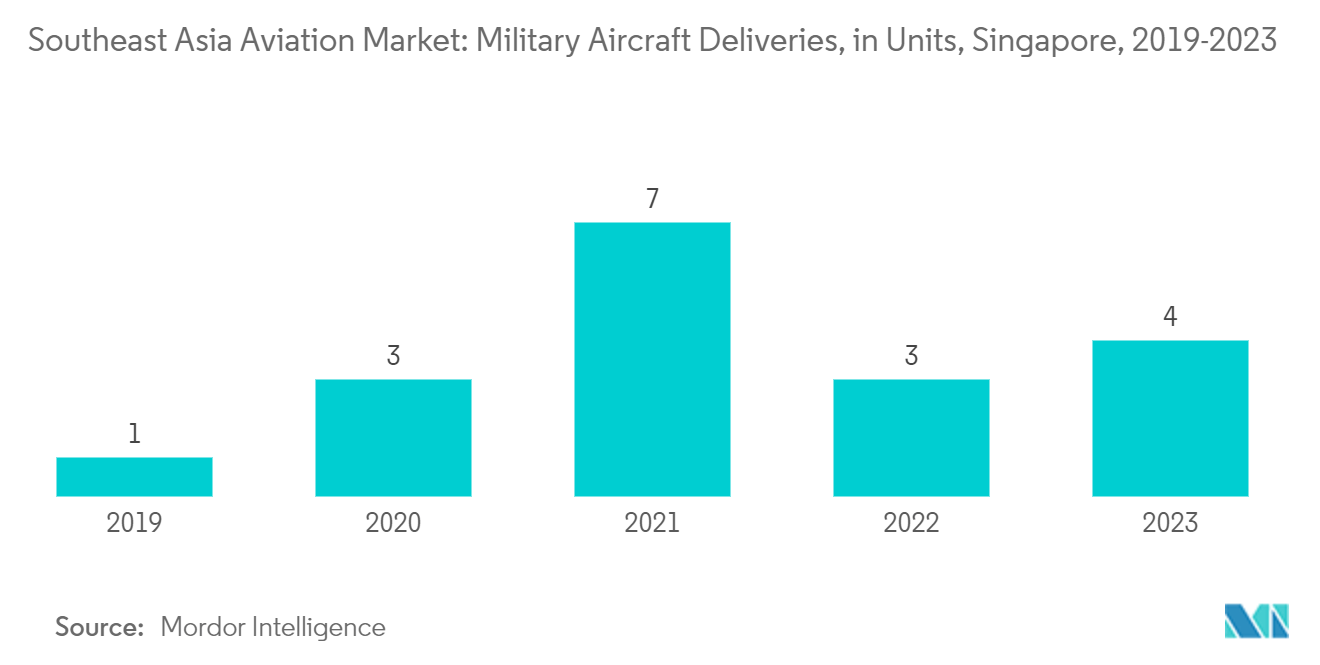Southeast Asia Aviation Market Size

| Study Period | 2019 - 2029 |
| Base Year For Estimation | 2023 |
| Market Size (2024) | USD 36.06 Billion |
| Market Size (2029) | USD 45.68 Billion |
| CAGR (2024 - 2029) | 4.84 % |
| Market Concentration | Low |
Major Players
*Disclaimer: Major Players sorted in no particular order |
Southeast Asia Aviation Market Analysis
The Southeast Asia Aviation Market size is estimated at USD 36.06 billion in 2024, and is expected to reach USD 45.68 billion by 2029, growing at a CAGR of 4.84% during the forecast period (2024-2029).
The expanding middle-income demographic in Southeast Asia and the surge in economic advancements have led to a rise in the accessibility and need for air transportation. This region has become a favored tourist hotspot, drawing in millions annually. The upsurge in tourism has contributed to the escalation of air traveler numbers in the area.
The aviation market in Southeast Asia is characterized by intense competition, wherein full-service and low-cost carriers vie for a portion of the market. This competitive environment places significant financial strain on airlines, necessitating stringent adherence to safety protocols amidst challenges such as airspace coordination and governmental regulations.
Focus on indigenous manufacturing by various countries in the region is also likely to boost the armed forces' procurement of various advanced aircraft and rotorcraft, which is expected to be one of the market growth drivers during the forecast period.
Southeast Asia Aviation Market Trends
The Commercial Aircraft Segment is Expected to Dominate the Market
Southeast Asia houses an immense population with a considerable share of the untapped passenger market for the commercial aviation industry. With the airlines gradually increasing their market penetration and the high use of the Internet, air travel is slowly becoming the preferred mode of transport. It is expected to grow extensively over the coming years. The growth in passenger traffic was primarily due to the increase in the disposable income of the people in the region and the growth in the tourism sector of various countries, like Indonesia, Thailand, the Philippines, and Singapore. Airlines such as Vietnam Airlines, Garuda Indonesia, and Singapore Airlines have planned aircraft deliveries for the forecast period as part of their expansion and fleet modernization plans.
As part of the fleet modernization plan, during 2018-2022, Thai Airways announced plans to phase out some of the Boeing B747-400s and Boeing B777s and ordered 15 newer generation aircraft. Such fleet expansion and modernization plans are anticipated to boost the segment's growth during the forecast period. Post the pandemic, travel and tourism have become an essential gateway for recreation, so several travelers are choosing to fly to their destinations. This is driving regional airlines to invest in improving their customer experience.
For instance, in April 2022, Malaysia Airlines announced the expansion of its partnership with Amadeus Altea Passenger Service System. With this expansion, the airline aims to provide high-end customer service to its flyers and offer numerous retail services to customers on board. Due to significant fleet expansion/modernization plans and airline investments in various parts of the market, the commercial segment is expected to witness the highest growth rate during the forecast period.

Singapore is Anticipated to Experience Significant Growth During the Forecast Period
Singapore is one of the major aviation hubs in Southeast Asia. The country's Changi airport is one of the world's busiest and most technologically equipped airports to handle huge aircraft like Airbus A380 and Antonov AN-225 Mriya. Furthermore, the country's homegrown airline and flag carrier, Singapore Airlines, is one of the leading carriers operating in the region and offering several long-haul flights, driving a significant passenger influx into the country. Owing to its proximity to China and Taiwan, the country has also been upgrading its defense capabilities to counter any unprovoked military aggression from the Chinese forces. Singapore's military spending was 3% of the country's overall GDP in 2022. The country's military spending as a percentage of GDP has been falling over time.
However, Singapore continues to invest more in its military than Malaysia and Indonesia. It declared a nominal increase of 3% over the allotment for 2022, at USD 11.3 billion. The country's defense strategy focuses on maintaining a solid and capable military to safeguard its sovereignty and national interest. For instance, in February 2022, the Republic of Singapore Air Force (RSAF) upgraded its Fokker-50 maritime patrol aircraft fleet; it is working closely with the navy to review the country's security threats. This is expected to drive the government to invest in multiple fleet modernization programs, creating market growth opportunities during the forecast period.

Southeast Asia Aviation Industry Overview
The Southeast Asian aviation market is fragmented and has enormous potential, as several countries are looking to enhance their commercial and military aviation fleets. Foreign players dominate the aviation market in this region. Some prominent players in the market are The Boeing Company, Airbus SE, Lockheed Martin Corporation, Textron Inc., and Rostec.
Foreign companies are also considering these countries to set up new manufacturing facilities for parts and components. This may help local aerospace companies to collaborate with foreign players to extend their market presence and gain new contracts. For instance, in February 2022, Singapore Airlines entered into a purchase agreement with Airbus for 7 A350F freighter aircraft. The newly ordered aircraft will replace the carrier's 747-400F fleet in the fourth quarter of 2025. Major aircraft manufacturers like Airbus have already set up manufacturing units across multiple countries in the region, capturing major portions of the market share and further tightening the competitive landscape in the region.
Southeast Asia Aviation Market Leaders
-
The Boeing Company
-
Airbus SE
-
Lockheed Martin Corporation
-
Rostec
-
Textron Inc.
*Disclaimer: Major Players sorted in no particular order

Southeast Asia Aviation Market News
February 2024: Thai Airways ordered 45 B787-9 Dreamliners with GEnx engines. Thai Airways selected the B787-9 to support its long-term strategy of renewing and expanding its fleet.
February 2022: Indonesia finalized the purchase of up to 36 F-15 jet fighters from the US as part of its defense fleet modernization program. This purchase is expected to increase Indonesia's defense strength against regional threats.
Southeast Asia Aviation Market Report - Table of Contents
1. INTRODUCTION
- 1.1 Study Assumptions
- 1.2 Scope of the Study
2. RESEARCH METHODOLOGY
3. EXECUTIVE SUMMARY
4. MARKET DYNAMICS
- 4.1 Market Overview
- 4.2 Market Drivers
- 4.3 Market Restraints
-
4.4 Porter's Five Forces Analysis
- 4.4.1 Threat of New Entrants
- 4.4.2 Bargaining Power of Buyers/Consumers
- 4.4.3 Bargaining Power of Suppliers
- 4.4.4 Threat of Substitute Products
- 4.4.5 Intensity of Competitive Rivalry
5. MARKET SEGMENTATION
-
5.1 Type
- 5.1.1 Commercial Aircraft
- 5.1.1.1 Passenger Aircraft
- 5.1.1.2 Freighter Aircraft
- 5.1.2 Military Aircraft
- 5.1.2.1 Combat Aircraft
- 5.1.2.2 Non-combat Aircraft
- 5.1.3 General Aviation
- 5.1.3.1 Helicopter
- 5.1.3.2 Turboprop Aircraft
- 5.1.3.3 Business Jets
-
5.2 Country
- 5.2.1 Singapore
- 5.2.2 Indonesia
- 5.2.3 Thailand
- 5.2.4 Philippines
- 5.2.5 Malaysia
- 5.2.6 Rest of Southeast Asia
6. COMPETITIVE LANDSCAPE
- 6.1 Vendor Market Share
-
6.2 Company Profiles
- 6.2.1 The Boeing Company
- 6.2.2 Airbus SE
- 6.2.3 Lockheed Martin Corporation
- 6.2.4 Dassault Aviation
- 6.2.5 Leonardo SpA
- 6.2.6 Textron Inc.
- 6.2.7 Rostec
- 6.2.8 General Dynamics Corporation
- 6.2.9 PT Dirgantara Indonesia
- 6.2.10 United Aircraft Corporation
- 6.2.11 ATR
- 6.2.12 Honda Aircraft Company LLC
- *List Not Exhaustive
7. MARKET OPPORTUNITIES AND FUTURE TRENDS
** Subject To AvailablitySoutheast Asia Aviation Industry Segmentation
The report considers revenues from new aircraft deliveries and affiliate service contracts. Similarly, the report analyses investments in new airports, aircraft procurement programs, defense spending, and various business expansions by multiple companies.
The Southeast Asian aviation market is segmented by type and geography. By type, the market is segmented into commercial, military, and general aviation. The report also offers the market size and forecasts for five countries across the region. The market sizing and forecasts have been provided in value (USD).
| Type | Commercial Aircraft | Passenger Aircraft |
| Freighter Aircraft | ||
| Type | Military Aircraft | Combat Aircraft |
| Non-combat Aircraft | ||
| Type | General Aviation | Helicopter |
| Turboprop Aircraft | ||
| Business Jets | ||
| Country | Singapore | |
| Indonesia | ||
| Thailand | ||
| Philippines | ||
| Malaysia | ||
| Rest of Southeast Asia |
Southeast Asia Aviation Market Research FAQs
How big is the Southeast Asia Aviation Market?
The Southeast Asia Aviation Market size is expected to reach USD 36.06 billion in 2024 and grow at a CAGR of 4.84% to reach USD 45.68 billion by 2029.
What is the current Southeast Asia Aviation Market size?
In 2024, the Southeast Asia Aviation Market size is expected to reach USD 36.06 billion.
Who are the key players in Southeast Asia Aviation Market?
The Boeing Company, Airbus SE, Lockheed Martin Corporation, Rostec and Textron Inc. are the major companies operating in the Southeast Asia Aviation Market.
What years does this Southeast Asia Aviation Market cover, and what was the market size in 2023?
In 2023, the Southeast Asia Aviation Market size was estimated at USD 34.31 billion. The report covers the Southeast Asia Aviation Market historical market size for years: 2019, 2020, 2021, 2022 and 2023. The report also forecasts the Southeast Asia Aviation Market size for years: 2024, 2025, 2026, 2027, 2028 and 2029.
What are the government regulations and infrastructure developments impacting the Southeast Asia Aviation Market?
The government regulations and infrastructure developments impacting the Southeast Asia Aviation Market are a) Airspace management policies b) Airport infrastructure investments
Southeast Asian Airlines Industry Report
The Southeast Asia aviation industry is on an upward trajectory, fueled by rising disposable incomes, increased tourism, and strategic government investments in aviation infrastructure. Its strategic geographic location has led to a surge in passenger traffic, spotlighting both commercial and military aviation sectors. The commercial segment, in particular, is booming, due to a growing middle-class and the region's appeal as a tourist hotspot, prompting airlines to expand and modernize their fleets. Additionally, advancements in airport infrastructure, supported by ongoing investment, are set to further drive market growth. The competitive landscape features both full-service and low-cost carriers, focusing on customer experience and operational efficiency. With a keen eye on sustainability and digital innovation for customer service improvement, the industry is embracing emerging trends. According to Mordor Intelligence™ Industry Reports, the market is experiencing significant growth, offering vast opportunities for stakeholders. For detailed insights, including market share, size, and revenue growth rate, a free report PDF download is available, providing a comprehensive analysis and forecast outlook of the Southeast Asian Airlines market.



